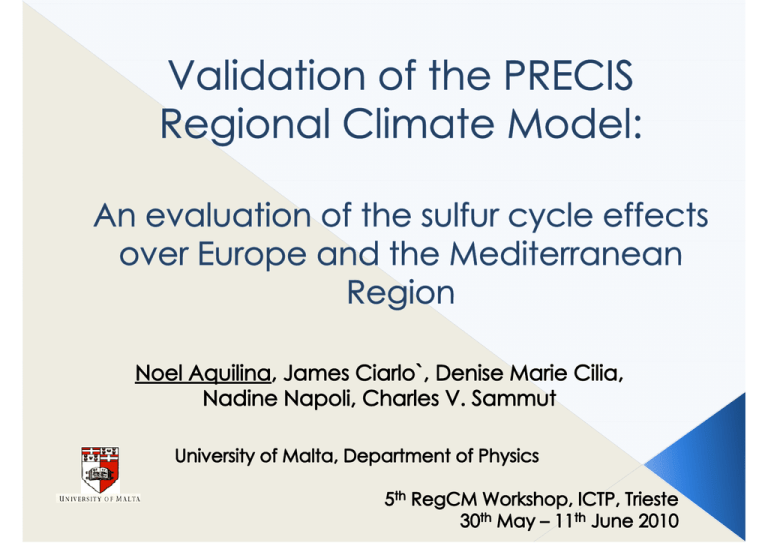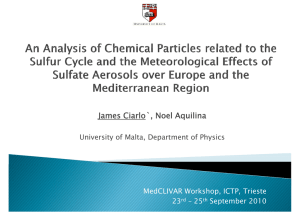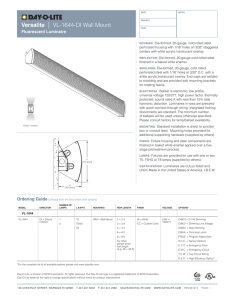Document 13345743
advertisement

What is PRECIS? The Physical Parameters Boundary Conditions Why the Mediterranean Basin? The Sulfur Cycle & Aerosols Aerosols Impacts D t A Data Analysis l i Sulfur Cycle Validation Future Scenarios Conclusions 2 2 The PRECIS ((Providing g REgional g Climates for Impact Studies) RCM is driven by the GCM HadAM3P. (Gordon et al, 2000) It is an Atmospheric and a LSM of limited area. The model is described in 3 units: The dynamics; The physical ph sical parameterizations; parameteri ations; The Sulfur cycle • • • 3 3 • Clouds & precipitation Large Scale & Mass flux productive Convective Radiation includes the seasonal and diurnal cycles of insolation Boundary layer can occupy up to the bottom 5 model layers – (Smith, 1990) Land Surface characteristics are prescribed according to climatological surface f types t • Surface exchanges L d surface Land f scheme h is i MOSES (Met (M t Office Offi Surface S f Exchange E h Scheme) S h )– (Cox et al, 1999) Gravity wave drag is applied to momentum components in the free atmosphere – Palmer et al, 1986) 4 4 Model requires surface boundary conditions from surface temperatures and ice extents. extents Dynamical atmospheric information at the boundary of the model model’ss domain are obtained from the LBCs which include - standard atmospheric p variables of surface p pressure - horizontal wind components - atmospheric temperature and humidity measures LBCs are updated every 6 hours of the model simulation time. time Surface boundary conditions are updated every day. 5 Mediterranean enclosed by 3 major continents; surrounded almost entirely by mountains. This makes the Mediterranean very unique and sensitive to climate changes. changes Si Simulation l ti d t il details › GCM-HadAM3P-150km › PRECIS (v 1.7.2) used › 1960-1990 (1-year spin up) › Resolution: 0.44° x 0.44° › 100 cells x ((50 km x 50 km)) › (57°N, 18°S, 16°W, 46°E) 6 6 Mode Nucleation Aitken Diameter (μm) <0.01 Lifetime Removal Process Minutes-Hours Coagulation 0.01-0.1 Hours-Days Coagulation Accumulation 0.1-1 Weeks Nucleation Coarse 1-10 Hours-Days Gravitation Gi t Giant >10 10 H Hours-Days D G Gravitation it ti The Sulfur Cycle y is based 5 variables: SO2, DMS and 3 modes 2 2of SO4 (One dissolved and 2 free modes) Model simulates transport of above via horizontal and g vertical advection,, convection and turbulent mixing Aerosols act as CCN SO422- increase droplet acidity (acid rain) Increase in aerosol causes climate impacts 7 7 Aerosol Impacts 8 Indirect: Cloud lifetime effect CLW #CCN Droplet size PPN Cloud Lifetime Cloud Thickness Indirect: Twomey (Cloud albedo) effect CLW (Fixed) (Fi d) #CCN Droplet size Di Direct: t Scattering S tt i effect ff t ↓SW ↓Skin Temp. Cloud Albedo/ Thickness Cloud Albedo Day-time D ti Solar Radiation Night-time Thermal Radiation Max TTemp. Min Temp. • • Direct: LW unaffected: Aerosol Opacity↓ as λ↑ Indirect: RH decreased: water vapour ↓ as condensation ↑ 8 Measured Modelled ESRL units PRECIS units Skin Temperature oC Surface (Skin) Temperature K Net SW Radiation Flux W m-22 Net Down Surface SW Flux W m-22 Net LW Radiation Flux W m-2 Net Down Surface LW Flux W m-2 DTR at 2 meters K DTR at 1.5 meters K Convective Precipitation kg m-2 s-1 Convective Rainfall Rate kg m-2 s-1 Cloud Water Content kg m-2 Cloud Liquid Water Content kg kg-1 R l ti H Relative Humidity idit % R l ti H Relative Humidity idit % 9 Measured Modelled Min = 107.4; Max = 234.7 Min = 68.9; Max = 256.4 1961-1990 10 11 12 12 Statistics of Parameters Parameter Conv PPN (x10‐6) DTR Net LW Net LW Net SW RH Surface T Correlation 0.47 ‐0.11 0 48 0.48 0.59 0.43 0.13 Average Bias Average Bias ‐3.08 ‐1.98 1 01 1.01 ‐10.45 ‐5.46 0.82 Max Bias Max Bias ‐1.48 ‐0.32 3 77 3.77 ‐6.99 ‐3.01 1.59 Min Bias Min Bias ‐5.80 ‐3.52 ‐1.37 1 37 ‐15.63 ‐8.38 0.05 › Bias of Conv PPN, DTR, Net LW, Net SW, RH: Suggests SO42- over-prediction › Bias of Surface T: Possible result of Net LW over-prediction › Bias of SO2: Suggests over-prediction in chemical reaction: SO2 → SO4213 13 Sulfate Abundance: 1. 2. 3. Aitken Accumulation Dissolved 14 14 Aerosol-sensitive parameters Effect Direct Direct Direct Direct Direct Aitken v SW Accum v SW SW v Skin T Aitken v Skin T Accum v Skin T Correlation -0.76 -0.82 0.69 -0.60 0 60 -0.64 Expected Relationship g Negative Negative Positive Negative Negative Direct Effect › Strong correlations › Expected relationships › Strong St evidence id off effect ff t 15 15 Aerosol sensitive parameters Aerosol-sensitive Indirect Effects: › Low detectability off effect ff t › Expected due to complex interactions “Incorrect” correlations: › Model errors? Effect Indirect Indirect Indirect Indirect Indirect Indirect Indirect Cloud lifetime Cloud lifetime Indirect Indirect Indirect Diss v Skin T Diss v SW SW v DTR Expected Correlation Relationship -0.77 Negative -0.82 0 82 Negative 0.50 Positive CLW v DTR Diss v CLW CLW v SW Diss v DTR -0.59 0.39 -0.28 -0.40 Negative Positive Negative g Negative Diss v PPN 0.43 Negative CLW v PPN CLW v LW Diss v LW LW v DTR 0.18 -0.26 -0.60 0.47 Negative Positive Positive Negative 16 16 Effect Cloud lifetime Cl d Cloud lifetime Expected Correlation Relationship Diss v PPN 0.43 (Negative) Negative CLW v PPN 0.18 Negative Positive Consider a cloud of increasing CLW Cloud lifetime effect Increasing Aerosol “Water-cycle effect” Constant Aerosol ↓ Droplet p size ↓ Precipitation ↑ Droplet size ↑ Precipitation “Water-cycle effect” >> Cloud lifetime effect 17 17 Effect Indirect Indirect CLW v LW Diss v LW Indirect LW v DTR Expected p Correlation Relationship -0.26 Negative Positive -0 0.60 60 Negative Positive 0.47 Negative Positive Consider a cloud with dissolved aerosol › Influenced by the indirect effect (↑ CLW/thickness/albedo) ↓ LW ↓ Max T. ↓ DTR ↑ LW ↑ Min T. ↓ DTR LW LW 18 19 19 SO2 mass mixing ratio at model level 5 20 20 SO2 mass mixing ratio (ppb) at various model levels at grid point (37.45°N, 14.59°E) – Location of Etna (dashed lines – non volcanic activity) 21 21 SO2 mass mixing ratio (ppb) at various model levels at grid point (37.20°N, 15.84°E) – Location of Plume (dashed lines – non volcanic activity) 22 22 Scenario Economic growth Population growth Focus A2 Slow High Slow technological change B2 Intermediate Intermediate Sustainability: economy society, economy, society environment A1B Very Rapid Efficient technology; Non/Fossil balance Peaks mid-century; declines after 23 24 24 25 25 › Model is able to produce topographical detail › Effect evidence and correlation: Direct: High evidence & Acceptable correlation Low-Moderate Moderate evidence & correlation Indirect: Low › Bias suggests problems with the Sulfur cycle: 2 emissions Possible i over-estimation i i off direct i SO42i i Possible over-estimation of SO2 → SO42› More validation and ensemble simulations are needed for confidence with climate change scenarios as based on the Sulfur cycle › More detailed analysis is needed for chemistry in the vertical layers 26 26 Mr. Adam Gauci Mr Mr. Pierre-Sandre Farrugia Dr. Dr Louis Zammit Mangion David Hein David Hassell http://precis.metoffice.com/ 27 Noell Aquilina N A ili E: noel.aquilina@um.edu.mt T +356 2340 3036 T: PRECIS MONITORING STATIONS 29 PRECIS MONITORING STATIONS 30



